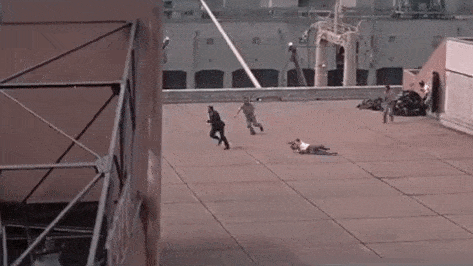Beyond the Frame #16: Director's Cut - Lewis Gilbert
/The following piece is a continuation of a series, Behind the Frame by Chris Rogers, which analyzes how the built environment has been represented on the big screen. Interiors will post future pieces on INTJournal.com.
Lewis Gilbert, who died two years ago aged 97, directed some of Britain’s best-loved films, including Reach for the Sky, Alfie and Educating Rita. Always humane and often featuring wry humour, his work was also distinguished by an unusual sensitivity to place. Whether at home or abroad, on location or the backlot, Gilbert’s interiors and exteriors play an integral role in his films.
The sub-genre called film noir originated in America during the 1940s but was quickly taken up by the Old World (a Frenchman coined the term). The British national character – reserve to the point of repression, a dry sense of humour – was well-suited to these sardonic thrillers, whilst global conflict justified the presence of guns. In The Good Die Young four men come together in a pub, each needing a thousand pounds and one proposing a robbery to obtain the money. This is executed in a night-time scene introduced by a slow crane down into a city street and in which a bridge and the façades of buildings are used by Gilbert to define his arena. Though clearly studio-bound, Gilbert nevertheless conjures a coherent urban realm through an understanding of atmosphere, evident in the wet streets, fog and shadow. When – inevitably in such narratives – the robbers’ plan disintegrates, the subsequent chase employs a genuine location shot with the same aesthetic. The white spire of a church looms out of the darkness, the rails of the London Underground gleam with damp and the wages of sin are earned.
The Good Die Young (1954)
Carve Her Name with Pride (1958)
The war itself was the setting for Carve Her Name with Pride, the story of English Special Operations Executive agent Violette Szabo and her undercover missions in occupied Europe. Gilbert begins by shooting outside Szabo's actual family home in a south London street, establishing a reassuring domesticity, before the action shifts to France. Here, when Szabo walks nervously through a deserted village at night, Gilbert again shows his skill as the sequence was in fact filmed in England at Pinewood studios or the neighbouring Black Park, yet it convinces utterly whilst adding a sense of menace.
A secret agent of a very different type whose own exploits would be simulated with vastly greater resources was the subject of no fewer than three films Gilbert directed in Eon productions’ James Bond series; each is noteworthy for its treatment of architecture and the built environment.
You Only Live Twice (1967)
You Only Live Twice (1967)
The Spy Who Loved Me (1977)
Moonraker (1979)
His first, You Only Live Twice, is perhaps best known for its villain’s headquarters concealed inside a volcano, bringing to life an extravagant backlot set by Ken Adam (see BTF #3). But the film was also one of the earliest Western productions to be shot in Japan and only the second Bond film to use the widescreen Panavision process, and Gilbert exploited both with élan. He contrasted the lush, green, natural landscapes of Himeji Castle and Mount Shinmoedake with the hard, gleaming surfaces of Tiger Tanaka’s high-tech train and the Modernist architecture of Osato Chemicals, ‘played’ by the then-new Hotel New Otani Tokyo (Gilbert repeated this juxtaposition when he returned to the country some years later – with members of the Bond crew – to make Seven Nights in Japan, a romantic drama).
A decade on, Gilbert’s The Spy Who Loved Me was shot in eight different countries, more than any Bond before or since, and the director continued to show his innate feeling for shooting architecture throughout. Night shooting featured prominently once more in the almost Expressionistic Great Pyramids sequence. This runs for a full five minutes with almost no dialogue, relying instead on camera angles, colour and the built forms of ancient tombs to create tension as protagonist and antagonist stalk each other as the nightly son et lumière plays out. Retained for the follow-up film, Moonraker, Gilbert again smoothly integrated complex sets representing highly artificial environments with location shooting around the world. This is seen in the dream-like quality that suffuses James Bond’s discovery of a spacecraft launching facility inside a Mayan jungle temple, another dialogue-free moment.
The Spy Who Loved Me (1977)
Operation daybreak (1975)
Before this pair of fantasies Gilbert told another true wartime story – the British-Czech plot to assassinate Nazi leader Reinhard Heydrich. The audacious mission succeeded, albeit at grievous cost, and the strength of Gilbert’s version lies in the truth of its locations. Much of the film was shot in an autumnal Prague, locus of the mission; the climax, in which German forces besiege the hiding place of the Czech agents, commences outside the very place where the events depicted actually occurred, the Chrám svatého Cyrila a Metoděje church. A dolly shot that follows soldiers running down a rain-wet street in raking late afternoon light demonstrates Gilbert’s empathy for the cinematic city; accurate recreation of the crypt air vent, which aperture sealed the agents’ fate, confirms it.
Showing a rare talent when filming everyday and exotic places, Lewis Gilbert knew what could lie beyond the frame.
Chris Rogers writes, speaks and creates tours about architecture and other aspects of visual culture. He has written three books, including How to Read London – A crash course in London architecture (Ivy Press, 2017), a publisher's best-seller. His work and thoughts on architecture, film, art, design and television can be found at www.chrismrogers.net



